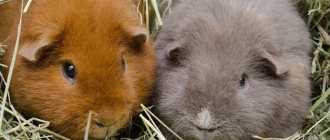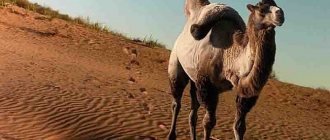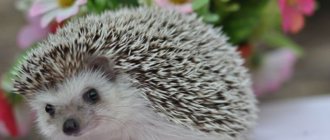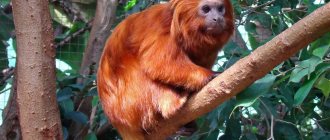Description, structure, characteristics
According to the zoological classification, hedgehogs belong to chordate mammals, the order Urchiniformes, and the family Urchinidae.
The length of a hedgehog, depending on its type, ranges from 10 to 44 cm. Also, the weight of a hedgehog can be from 300 grams to 1.5 kilograms. This animal also has a tail; the hedgehog’s tail grows from 1 to 21 cm in length.
The hedgehog's head is very large, wedge-shaped, and its muzzle is elongated; it is decorated with a movable and always moist hedgehog nose.
The hedgehog's teeth, although small, are quite sharp. The upper jaw usually has 20 teeth, and the lower jaw has 16. The first two upper teeth are large and fang-like. Although some species of hedgehogs have as many as 44 teeth. Now you know the answer to the question, how many teeth does a hedgehog have?
The hedgehog's hind legs are longer than its front legs, and each paw has five toes. The only exception is the white-bellied hedgehog, which has only four toes. Hedgehogs are clean animals and periodically clean their quills using their long middle fingers.
The sharp spines or needles of a hedgehog are its signature feature, a kind of calling card of this animal. They serve them both for protection from predators - in times of danger, hedgehogs curl up into a ball, the outside of which is full of thorns, and for transporting various food supplies - hedgehogs often prick apples or mushrooms on their needles in order to transfer them to their burrow.
On average, each hedgehog has up to 10 thousand spines. The color of the needles of most types of hedgehogs is dark and has rare light stripes. The color of a hedgehog's fur, depending on its type, can be brown, sand, black-brown or white.
Being a nocturnal animal, the hedgehog has poor eyesight, but a well-developed sense of smell and hearing.
And although hedgehogs are land animals, they can swim and climb trees quite well.
Features and habitat of the hedgehog
There are more than 20 different types of hedgehogs, but they are largely similar and recognizable due to their elongated muzzles on a rather large head for an average-sized hedgehog up to 20 cm long. The beady eyes are very lively and expressive, but they see poorly. But the sense of smell and hearing are excellent, although the antennae on the constantly wet and mobile nose and ears are small.
Many people mistakenly believe that the hedgehog is a group of animals
with family ties.
In fact, the similarity is deceptive; relatives of hedgehogs live among shrews and lesser-known tenrecs and gymnurs. An animal that looks like a hedgehog
with its prickly clothes is not always its relative.
Thus, a sea urchin is an animal that
has no resemblance to a forest dweller, except for the name.
Hedgehog is an insectivorous animal
, the average weight of the animal is almost 800 g, but before hibernation it gains weight to about 1200 g. Males are slightly larger in size than females. The hedgehog's front legs are shorter than its hind legs, and five toes on each are equipped with sharp claws. The small tail, up to 3 cm, is almost invisible under the animal’s needle-like coat.
Brownish-light needles up to 3 cm in size, hollow inside. Under each needle there is a muscle fiber that can raise and lower it. Approximately 1-2 needles out of three grow and fall out every year. There is no complete shedding of the fur coat; gradual renewal of the coat occurs over a year and a half. Only sick individuals shed their needles.
The number of spines in one adult hedgehog reaches 5-6 thousand, and in a young animal - up to 3 thousand spines. There are also sparse blond hairs between the needles, but on the belly and head they are thick and darker in color. The gray plain woolen coat is more common, but among the hedgehogs there are white-bellied and spotted species.
Hedgehogs are known to curl up into a spiny ball if danger threatens. This possibility is associated with the work of the circular muscles, the ability to stretch the upper layers of the skin.
Animals can remain in this state for a long time until the threat passes. The needles grow at different angles and form a strong interweaving of spines. Such an impregnable ball.
Animal hedgehogs
inhabit only two continents: Eurasia and the northern regions. Despite the similarity of the climate of Europe and, there are no hedgehogs there anymore, although fossil remains indicate a former settlement.
Mixed forests and copses, grassy plains, overgrown river floodplains, steppes, and sometimes habitats of prickly animals. Only swampy places and coniferous areas are avoided. Your hedgehogs' territory in the animal world
They do not mark, they live alone, mainly in a certain territory, which they regularly explore in search of food.
Hedgehogs are often found near human habitation or economic activity: in park areas, abandoned gardens, on the outskirts of cities and in grain fields. Forest fires, bad weather or lack of food contribute to this.
Lifestyle
As permanent habitats, all hedgehogs dig secluded burrows under tree roots or in bushes. However, there are also lazier hedgehogs who, instead of digging holes on their own, prefer to occupy the abandoned holes of other animals, usually rodents.
Hedgehogs are nocturnal animals and lead a corresponding lifestyle, sleeping in their burrows during the day and going out hunting at night. At the same time, they are very sedentary homebodies and even during hunting they prefer not to stray far from their burrow-dwellings. Also, hedgehogs are individualists who lead a solitary lifestyle; they meet with their fellows only for the purpose of procreation.
Character and lifestyle of a hedgehog
Hedgehogs are nocturnal animals
During the day, they hide among the foliage and windbreaks of bushes, between the roots of plants. They do not like heat and hide in shallow, cool burrows or nests made of dry grass, moss, and leaves. The dimensions of such a dwelling are slightly larger than the size of the owner, up to 20-25 cm. Here the animal takes care of the fur coat on its chest and abdomen, licking it with its tongue.
In the dark, a subtle sense of smell helps, vision and hearing contribute. The activity of the animals reflects the route, reaching 3 km per night. Short legs do not allow them to move quickly, but with quick steps, hedgehogs are carried rapidly for their size at a speed of up to 3 m/sec. In addition, hedgehogs are good jumpers and swimmers.
What type of animal is a hedgehog?
by character, everyone knows. He is peaceful, but he has many enemies in nature: wolves, ferrets, kites, eagle owls,... When meeting an enemy, the hedgehog first jumps on the predator in order to prick, and then the ball of needles becomes an impregnable fortress. Having punctured the paws and muzzle, the attacker loses interest in the prey and leaves.
But there are cunning ways to deceive the simple-minded hedgehog. Those animals who eat hedgehogs
, have the intelligence of a predator. The insidious one silently attacks and seeks to take its prey by surprise.
Strong scales on the bird's feet protect against prickly pricks. The fox tricks the hedgehog into the water or throws it from a hill into a pond. Having opened its abdomen and muzzle, a swimming animal becomes vulnerable to a predator.
In a duel between a hedgehog and a snake
the winner will be the fearless prickly animal. Grabbing her by the tail and curling into a ball, he patiently pulls her under him. An interesting fact is that hedgehogs are insensitive to many poisons.
For example, the caustic blood of caterpillars or ladybugs, bee venom, and the cantharidin of Spanish flies do not harm the prickly inhabitants, although such poisons cause death to other animals.
Hydrocyanic acid, opium, arsenic or sublimate have a weak effect on hedgehogs. By autumn, the animals accumulate fat for hibernation. Species of hedgehogs living in the southern regions remain active all year round.
The hibernation period takes place in the hole. The body temperature drops and the pulse decreases to 20-60 beats per minute. Awakening occurs in the spring when the air warms up by April. If there is not enough subcutaneous fat, the animal may die of starvation.
Hedgehogs know their areas and protect them from the encroachments of their relatives. Females occupy up to 10 hectares of area, and males occupy 2-3 times more. Their stay is indicated by noisy snorting, sounds similar to sneezing. Baby hedgehogs whistle and quack like birds.
Nutrition
What do hedgehogs eat in the wild? Hedgehogs are omnivores, eating various fruits (apples, pears, strawberries, raspberries, blackberries), mushrooms, moss, acorns; and other living creatures: large insects (beetles, spiders, locusts, caterpillars, earthworms), bird eggs. Larger species of hedgehogs can hunt
lizards, frogs, mice. Being resistant to poisons, hedgehogs also attack poisonous snakes and scorpions.
It is very important for hedgehogs to fatten well over the summer and autumn and gain fat reserves, otherwise they may die during their winter hibernation, into which they fall, like bears, with the onset of winter cold. It is a good supply of fat that allows hedgehogs to remain in a state of suspended animation (the scientific name for hibernation in animals) until spring.
What does a hedgehog eat in nature?
The hedgehog is a small prickly predator. In nature, it feeds on insects, snails, worms, larvae, beetles, and frogs. Since it is a predatory animal, it often preys on small rodents.
Many gardeners even welcome it when a hedgehog comes to their site. He is a little house helper. With great pleasure, he eats pests on the site, thereby saving the harvest. Therefore, gardeners often feed wild hedgehogs in their summer cottages.
It also brings benefits by driving away all rodents and snakes from its territory. The hedgehog destroys the nests of mice, eating the offspring. And snakes are natural enemies of hedgehogs, like foxes, martens and owls. The hedgehog has an increased tolerance to snake venom, so bites are not scary for him, and he fights snakes without fear.
Types, photos and names
The hedgehog family consists of two large subfamilies: true hedgehogs and rat hedgehogs (hymnurs), united in 7 genera and 23 species. Next we will describe the most interesting types of hedgehogs.
European hedgehog
He is also an ordinary hedgehog, the most common representative of the hedgehog family. The body length of the common hedgehog is 20-30 cm, with a weight of 800 g. It lives throughout Europe, however, it can also be found in some Asian countries.
long eared hedgehog
A characteristic feature of this hedgehog, which gave it its name, are its unusually long ears, growing up to 5 cm in length. Eared hedgehogs are relatively small, ranging from 12 to 27 cm in length, weighing up to 430 g. They live in many countries in Africa and in Asia Minor and Central Asia; they can also be found in India and China.
Eastern European hedgehog
In appearance it is very similar to the European hedgehog, but has a slightly different color, namely the front part of the neck and belly is lighter. It grows up to 35 cm in length and weighs 1.2 kg. It lives not only in Eastern Europe itself, but also in the Urals, as well as a number of countries in the Middle East.
African pygmy hedgehog
This small hedgehog living in Africa is remarkable for its appearance; the tips of its needles, unlike other hedgehogs, are not black, but white. He also has the habit of screaming and snorting loudly in case of danger. The body length of the African pygmy hedgehog is 15-22 cm, weight 350-700 g. It lives south of the Sahara Desert in a number of African countries: Nigeria, Sudan, Ethiopia, Senegal, Mauritania.
Long-spined hedgehog
This hedgehog got its name thanks to its long and thick spines, even by hedgehog standards. The length of its needles is 4-4.2 cm. The needles themselves have different colors, it can be either light or black. The body length of this hedgehog is 22-27 cm, with a weight of 500 to 900 g. It lives in the Middle East and the Arabian Peninsula. Listed in
Red Book of Uzbekistan.
Daurian hedgehog
This is a steppe hedgehog that lives from the steppes of Transbaikalia to Mongolia and Northern China. Unlike other hedgehogs, the spines of this species are shorter and sandy or brown in color. The fur of this hedgehog is gray or dark brown in color.
mass of a hedgehog, the largest hedgehog
An adult hedgehog that lives in nature should weigh about 600 grams. Most individuals have a mass of approximately this, but there are also minor deviations. Let's consider how much the largest hedgehog in the world weighs.
Hedgehog mass
It is difficult to answer where the largest hedgehog lives, because tracking these individuals is not as easy as many people think. A large number of these animals live in the steppes, in Siberia, they actively fatten up for wintering. Because of this, their body weight almost doubles by the winter season.
The largest representatives of the species are common hedgehogs. The body weight of such individuals is in the range of 600-800 grams, and by the period of hibernation they gain up to 1200 grams. Females are usually smaller than their male counterparts.
The largest hedgehog
As already noted, the mass of an ordinary hedgehog is about 600 grams. But there are real giants. For example, a very large hedgehog was found in Scotland. This fat guy weighed a whopping 2.335 kg. He had cute chubby cheeks, a very large belly and small paws. Outwardly, of course, he looked quite nice, but his state of health was disappointing. After all, this is serious obesity, an animal with such mass and volume is not even able to curl up into a ball; it moves with great difficulty.
Reference. The weight of the world's largest hedgehog was 2.335 kg. This figure is four times higher than the norm. The fat boy was named Arbuckle.
This hedgehog was very lucky as he was discovered and subsequently placed under strict veterinary control. He was put on a strict diet and did active exercises regularly. As a result of the help of specialists, it was possible to reduce the weight of the animal by 1.5 kg.
Reference. This prickly animal was fed cat food, which led to such serious obesity.
When keeping these animals at home, it is very important to provide them with a proper and complete diet. Feeding unsuitable or fatty foods may well lead to obesity and the development of problems with the functioning of internal organs.
Interesting. In nature, these babies live only 3-5 years, while at home they live up to 15 years. This is due to the fact that in nature their lives are threatened by numerous predators.
Reproduction
These animals reach sexual maturity at 10-12 months. The mating season for hedgehogs begins in the spring, immediately after hibernation ends. At this time, the males begin an active search for a suitable female for mating; it often happens that several males lay claim to one female, then a fight occurs between them and the strongest gets the female.
Interesting fact: before mating, the female hedgehog thoroughly smoothes her spines.
Hedgehogs are polygamous animals, and having completed his simple task, the male leaves the fertilized female. A hedgehog's pregnancy lasts from 34 to 58 days, after which 1 to 7 small hedgehogs are born. Newborn hedgehogs are born like kittens, blind, and very small, their birth weight is 12 grams.
During the first day of life, soft light needles grow on their body, and after 2 weeks the needle-like cover completes its formation. At first, hedgehogs are under the close care of their mother, who feeds them with her breast milk. But after a month, the hedgehogs begin to grow rapidly, and soon leave their mother’s care, becoming adult hedgehogs.
Home care and maintenance
Recently, hedgehogs are increasingly becoming unusual pets, especially since keeping such a prickly pet is not so difficult. The main thing is that you should not take a hedgehog from the forest into your home, as it can be a carrier of dangerous diseases, such as ringworm or salmonellosis. If you really want to get a pet hedgehog, then you should contact a professional breeder who guarantees the pet’s health and adaptation to life in captivity.
So, first of all, the hedgehog in the house needs to be given a decent home. It can be wooden or
metal cage with tray. The cage must have straw or sawdust, a bowl of water and food.
Letting a hedgehog roam freely around your apartment or house is not the best idea; it can get tangled in wires, get hurt, or chew on your things.
The hedgehog's cage should be constantly cleaned of dirt to avoid an unpleasant odor. And since hedgehogs are nocturnal and solitary animals, you should not place two or more hedgehogs in one cage (if you really want to have several pet hedgehogs, then each should have its own individual cage). You should also be prepared that at night hedgehogs will actively rustle, puff, and generally go about their nightly hedgehog business.
Constance Hedgehog Collection
This hedgehog collection isn't just an online collection - it's an adventure taking place in our home!
Don't forget to check back from time to time to see what's new. The latest hedgehog to join us is:
| added January-24-2020 to ceramics Show the latest collection in the ceramics category I have listed 5214 items in the collection so far (excluding 394 items that are doubles or on my wishlist. I'm still in the process of shooting and uploading photos) At the auction of doubles you can find hedgehogs that I am ready to exchange |
.
What to feed at home?
Raw, lean meat, boiled liver, and fresh fish are ideal foods for hedgehogs. As delicacies, you can offer him live cockroaches, mealworms or
crickets. Hedgehogs will also happily eat apples and carrots.
People often wonder if hedgehogs can have milk. Let’s answer: no, you can’t, hedgehogs are intolerant to lactose, which is in milk, so milk can cause not only an upset stomach in a hedgehog, but even lead to its death.
When do hedgehogs hibernate?
As we wrote above, hedgehogs hibernate. Although hedgehogs living in captivity don’t seem to need it, you can’t fool the biological mechanism of the animal, the mechanisms of hibernation are laid down at the level of instincts, so you should be prepared that your prickly pet will also go into hibernation during the winter, perhaps not for such a long time like hedgehogs living in natural conditions.
To successfully survive winter hibernation, the hedgehog must be fed especially intensively in the fall in order to accumulate the necessary fat reserves. In November, you will notice how the hedgehog becomes lethargic and seems to be in a daze; in fact, this is the beginning of hibernation. Since in nature hedgehogs spend the winter in their nests, it is necessary for a domestic hedgehog to create conditions close to natural ones. To do this, select a secluded place somewhere in the loggia or attic, it is important that the temperature there does not exceed 5 degrees C. And create a kind of nest, put straw, dry
leaves, sawdust, rags, and then a sleeping hedgehog.
If you have an African pygmy hedgehog, then you don’t need to worry about hibernation, since this type of hedgehog does not hibernate due to the lack of winter in its habitat.
Ezhikov - facts, information and images
Hedgehogs are native to mainland Britain and throughout Northern and Western Europe. Related and similar species are also found in North Africa, the Middle East and Central Asia. There are 16 species of hedgehogs in five genera, found in parts of Europe, Asia, Africa and New Zealand.
There are no hedgehogs in Australia, and no living species native to North America. Present in New Zealand.
The estimated pre-breeding season hedgehog population in the UK is around 1,555,000. Many die from eating poisoned slugs.
Hedgehog Description
Hedgehogs are easily identified by their spines, which are hollow hairs stiffened with keratin. Their spines are not poisonous or jagged, and unlike porcupine quills, they cannot be easily removed from the animal.
However, spines typically fall out when the hedgehog sheds baby spines and replaces them with adult ones. This is called "quilling."
Under severe stress or during illness, a hedgehog may also lose its spine. Their underparts are covered with coarse gray-brown fur, forming long skirts on the sides. The hedgehog is about 23 centimeters long and its tail is 4 centimeters. They can weigh up to 2 kilograms. The Hedgehog has a powerful forefoot and claws for digging.
Hedgehogs have 5 toes with short claws on their front paws. However, their hind feet have 4 toes with long, ever-growing nails. They have these characteristics because hedgehogs dig burrows. They can also climb, swim and run at a surprisingly fast speed of 6 miles per hour.
Hedgehog habitat
Hedgehogs build nests from moss and leaves under vegetation around parks, gardens and farmland. They prefer forest edges, hedgerows and suburban gardens where food is plentiful.
Hedgehog Diet
Hedgehogs are not only insectivores, but also almost omnivores. Hedgehogs eat insects, snails, frogs and toads, caterpillars, worms, beetles, snakes, bird eggs, carrion, mushrooms, roots, berries, melons and watermelons. His favorite food is slugs and worms, they can eat 40 or more slugs per night .
Hedgehog behavior
Hedgehogs have changed little over the past 15 million years. Like many of the first mammals, they adapted to a nocturnal lifestyle.
The male Hedgehog is called "Boar" and is slightly larger than the female Hedgehog, which is called "Pig".
Hedgehogs overwinter alone from November to April under support structures such as a shed, wood piles, blackberry patches, open compost bags or fire piles. However, they may emerge to feed at night during warm winter periods. In summer, hedgehogs take refuge during the day in temporary nests made of leaves, moss and grass. By autumn, hedgehogs sharply gained weight, preparing for winter hibernation. They hibernate until the following March or April, during which time their body temperature and heart rate plummet from 190 to 20 beats per minute. Most hedgehog deaths occur during this hibernation period.
When threatened, hedgehogs can curl up into a ball for protection from predators. Their biggest enemy, other than humans, is the badger. The rotation causes all the spikes to face outward. However, its effectiveness depends on the number of spines, and since some of the desert urchins have evolved to carry less weight, they are much more likely to try to escape and sometimes even attack an intruder by attempting to ram the intruder with their spines. leaving rolling as a last resort. This results in different numbers of predators for different species. Smaller species, such as the long-eared hedgehog, are hunted by foxes, wolves and mongooses.
All hedgehogs are primarily nocturnal, although different species may be more or less likely to come out during the day. Most of the day the hedgehog sleeps under the cover of bushes, grass, stones or in a hole in the ground. Again, different species may have slightly different habits, but in general, hedgehogs dig holes for shelter. All wild hedgehogs can hibernate, but not all. Hibernation depends on temperature, type and abundance of food.
Hedgehogs sometimes perform a ritual called "anointing." When the animal encounters a new scent, it licks and bites the source, then forms a fragrant foam in its mouth and sticks it onto its spines with its tongue. It is unknown what the specific purpose of this ritual is, but some experts believe that the anointing camouflages the hedgehog with a new scent from the area and provides a possible poison or source of infection for any predator that pokes it with its spines. The anointing is sometimes also called "ant" due to the birds' similar behavior.
Hedgehogs are a powerful pest control agent. A single hedgehog can protect an average garden from pests by eating up to 200 grams of insects every night. In the UK it is common to see people trying to lure hedgehogs into their gardens with treats and hedgehog-sized holes in their fences.
Hedgehog Reproduction
The hedgehog's dilemma is based on the obvious danger of a male hedgehog injuring his spine while mating with a female. However, this is not a problem for hedgehogs, since the male's penis is very close to the center of his abdomen (often mistaken for his belly button), and the female has the ability to curl her tail up to to the point that her vulva protrudes behind the rest of her body. Thus, the male does not have to completely possess the female during mating.
The gestation period is from 35 to 58 days, depending on the species. The average litter is 4-7 newborns for larger hedgehog species and 5-6 for smaller ones. Soft, pale-colored spines appear a few hours after birth and take 3 weeks to harden. Hedgehogs are born blind. Many people believe that they are born without feathers, which develop in the following days. However, the quills are clearly visible within a few hours after the hedgehog is born. Young Hedgehogs become independent from their mother at 4-6 weeks. Like many other animals, an adult male hedgehog often kills newborn males.
Hedgehogs live quite a long time for their size. Larger species of hedgehogs live 4-7 years in the wild (some have been recorded up to 16 years), and smaller species live 2-4 years (4-7 in captivity) compared to a mouse at 2 years and a big rat. at 3 - 5 years. The absence of predators and a controlled diet contribute to increased lifespan in captivity.
Conservation status of hedgehogs
Hedgehogs are protected under the UK Wildlife and Countryside Act and cannot be captured without a licence. They are not considered endangered, although their numbers are declining due to habitat loss.
Hedgehogs are often killed by human-caused causes such as ponds, fires, roads, mowers and lawn mowers, pesticides, garden nets and litter. They are also killed by foxes, martens, stoats and badgers.
Provide a home for hedgehogs
Choosing a house for a hedgehog
Making a house for a hedgehog is very simple. Covering a sturdy, upside-down box with rocks, dirt, or wood may be enough to create habitable conditions. Leave a path for hedgehogs to enter and exit. You can also make or buy specially designed wooden hedgehog boxes. Make sure the wood you use or buy is from a sustainable source.
Make sure your hedgehog box is sturdy as both badgers and foxes prey on hedgehogs. Of course, the easiest way to house a hedgehog does not require much effort on your part. Help them build their own home by creating hedgehog-friendly areas around the garden. Available space under a shed or hedge, log piles and compost piles are all favorites.
Location of the hedgehog house
Locate the house in a quiet spot in the garden, against a wall, bank or fence, if possible, under or near vegetation. Make sure the entrance doesn't face north or northeast for a better chance of settlement.
Don't fill the box. Hedgehogs make their own nests from leaves and other garden debris. Do not touch the box when it is occupied, as you may scare the nesting mother and abandon the chicks. Like slugs and snails, hedgehogs are often found in damp, grassy areas of the garden. If you have or can create an unkempt area near their nesting area, hedgehogs will be able to forage more easily and will have a protective covering.
Dangers associated with hedgehogs
Always check compost heaps and firewood piles for hedgehogs before disturbing them, as they may nest in them. Fruit nets and netting can be dangerous for hedgehogs (and other animals) that may get caught in them.
Lawn mowers and mowers can be deadly. Be especially careful when cutting longer grass. Avoid using granules and other garden chemicals. They can harm hedgehogs. It's best to encourage hedgehogs to keep these pests under control. Since hedgehogs have quite a large territory, they may use several different gardens to find food, and if you want to encourage them, they will need to be able to move in and out of yours.
Even more interesting animals to learn about
.
Interesting Facts
Video
And in conclusion, an interesting documentary on the topic of our article - “The Hedgehog - the Garden Warrior.”
Author: Pavel Chaika, editor-in-chief of Poznavaika magazine
When writing the article, I tried to make it as interesting, useful and high-quality as possible. I would be grateful for any feedback and constructive criticism in the form of comments on the article. You can also write your wish/question/suggestion to my email [email protected] or Facebook, with respect, the author.
Author page











